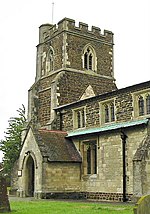Eggington House

Eggington House is the manor house of the village of Eggington situated near Leighton Buzzard, Bedfordshire, England. The house is regarded as a very fine example of late 17th century domestic architecture, and is a Grade II* listed building. At the time of its construction in 1696 it was completely up to date and innovative in its design - which was unusual in the provinces, where architectural styles usually lagged behind that of the larger cities. This small mansion, built for a Huguenot from Montauban in France, a Merchant taylor John Renouille who became Sheriff of Bedfordshire. The house is of red brick. The main facade is of seven bays of classical sash windows and three storeys high. The roof line is concealed by a panelled parapet decorated with urns. The interior contains a staircase with twisted balusters. The house has had a varied ownership, the Renouille family anglicised their name to Reynal moved to nearby Hockliffe Grange and let Eggington. The last of the Reynal's predeceased his wife, who remarried which caused to the property to pass to her new husband named Francis Moore. By 1840 Eggington House belonged to a family called Adams. Later, circa 1900, it belonged to a family called Hodgson who frequently entertained the suffragette Sylvia Pankhurst. During World War I the house was requisitioned by the Army. From 1950 to 1976 it was the home of Sir Gilbert Inglefield, the 1967 Lord Mayor of London, and his wife. It was then the residence of Lord Slynn of Hadley and his wife. Today, the house remains in private ownership.
Excerpt from the Wikipedia article Eggington House (License: CC BY-SA 3.0, Authors, Images).Eggington House
High Street,
Geographical coordinates (GPS) Address Nearby Places Show on map
Geographical coordinates (GPS)
| Latitude | Longitude |
|---|---|
| N 51.9173 ° | E -0.61145 ° |
Address
White House Residential Home
High Street
LU7 9PQ
England, United Kingdom
Open on Google Maps







